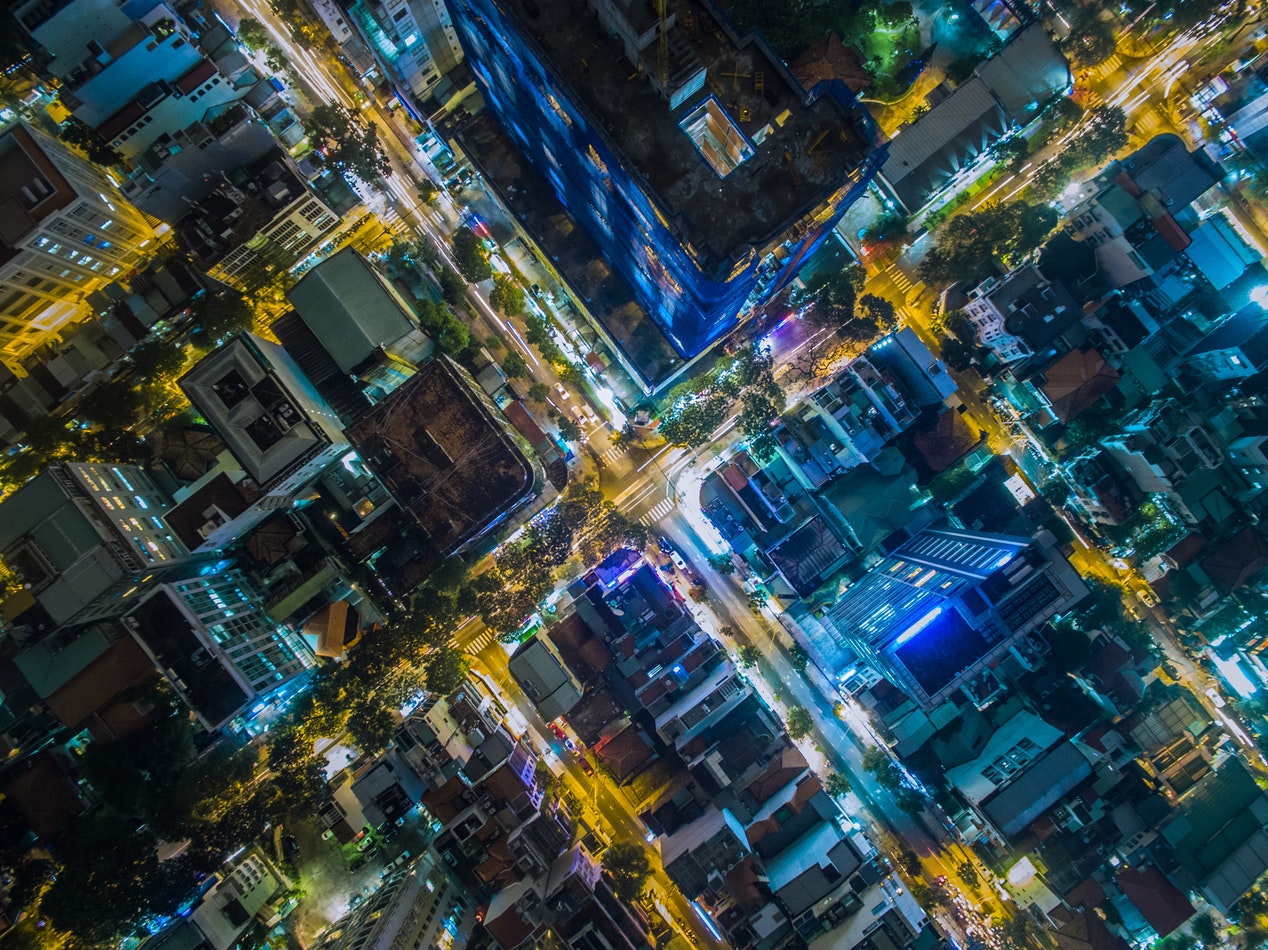The idea of the “Smart City” is a fashionable one. However, there is no common definition of what a smart city should look like. Diverse initiatives have been realised under the moniker of “smart solutions”, from the creation of green spaces to self-driving vehicles. The great variety and creativity of these initiatives demonstrates the enormous potential of smarter cities to save resources, share information seamlessly on a fair basis and facilitate communication between machines and humans to create new, more efficient ways of operating in the city. Technology is central to this, with one article making the case that “the concept of ‘smart city’ might become an icon of a new digitally facilitated form of living in urban space.” Smart is the notion of leveraging technology to understand and respond to the situation of the city on a granular level and in real time. What many “smart” initiatives lack so far is an integrated approach. If the vision of a smart city encompasses every element of city life – from traffic control to lighting, from green spaces to medical care – and address these areas by leveraging technological solutions, the opportunities for increased efficiency are multiplied. In many ways, the smart city is a canvas on which to build and innovate, a process that demands collaboration between industry and government, as well as special insight and guidance from experts in the field.
Key Components
There are four key components to the operation of a smart city: i) a strong dataset; ii) effective communications; iii) timely decision-making; and iv) effective action.
The lifeblood of a smart city is the vast amount of data captured from local conditions and a multitude of daily processes and activities. A smart city demands a dataset that is vast, accurate and reliable. So-called city sensors collect data in real time regarding available parking spaces, levels of road traffic, energy consumption, waste management and multiple other sources. This sea of data can provide a granular perspective of how a city is functioning and be used as an input for sophisticated decision making algorithms.
However, it is impossible to leverage the power of data without the digital backbone of an efficient communications network in order to transport it. The communications network of a smart city is responsible for getting the right information to the right place at the right time, using technologies such as IoT and wireless sensor networks (WSNs). Data must be shunted from a city sensor to a decision-maker and from the decisionmaker to the responder quickly and securely, in order for the response to be timely. This demands infrastructure with the necessary power supply, reliability, cybersecurity and connectivity. 5G, with the speed and connectivity it lends to IoT, makes it essential to the development of smart cities. It is powerful enough to enable both massive machine type communication (MMTC) and critical machine type communication (CMTC), which are vital for applications where the transfer of data is delay-intolerant. As a result, 5G is set to play a “critical role in allowing information gathered through sensors to be transmitted in real time to central monitoring locations”.
The decision-maker is the component that allows the city to react to information, once data has been collected and transferred. AI, cloud computing and big data are some of the major solutions that can be leveraged by smart cities to analyse huge amounts of data. These technologies are considered fundamental to smart city projects, as human decision-makers lack the speed and capacity required to handle the enormous amount of data generated by cities in constant flux. The optimisation of one or more metrics governs the decision-making process. A smart city may decide: which route an autonomous vehicle should take in order to minimise the time that it and other vehicles spend in traffic; the right voltage level delivered by a transformer to maximise the efficiency of the entire electricity grid; or, the amount of authentications that may be required for a purchase to reduce the probability of unidentified fraud. At the core of every decision made by a smart city is the goal of maximising or minimising something that is desirable by the residents of the city.
Once the appropriate course of action is defined, it needs to be executed. That takes us to the last component of a smart city: effective action. Through the communications network, smart devices are ordered to act in specific ways that optimise overall performance. At this stage, coordination between a variety of devices is often pivotal. Traffic lights in a smart city receive the order to open and close in a particular manner so that traffic is minimised and an ambulance can arrive at an emergency site as fast as possible. In the last component of a smart city, the smart devices are mere executors of the plan derived from the decision-making entity. After the smart solution has been deployed, the smart city must resume the data collection process to assess the impact of that solution on overall performance and potentially employ other actions. The data is collected and transported, through a communications network, to a decision-making entity. There, a set of actions is defined for all the relevant smart devices. These devices are informed on what to do and execute those orders, while sensing devices continue to collect data on the new status of the system.
This loop can be applied to several domains of a city. We have chosen to group smart city applications into five domains: security, healthcare, mobility, utility, and finance. Other sources provide slightly different classifications. The building blocks for each one of these applications are known, well-established technologies, but also modern innovations. Smart and adaptive sensors can be used to collect data from infrastructure, assets, people, and the environment, while blockchain can ensure trust in the validity of the data. Using 5G, local-area networks and other connectivity technologies, the information can be transported to a decision-making entity, where artificial intelligence can plot the ideal course of action. Returning to the communications network, the commands reach smart devices that can implement decisions which benefit residents of the city. Some of these technologies are discussed in the next sections.
The Role of Drones
Only recently have we begun to realise the potential of drones in cities of the future. Either remotely controlled or autonomous, drones have a wide range of applications, from transporting products or hardware to assessing hard to reach places. One example is that of parcel delivery. In partnership with regulators and industry, some companies are supporting the development of a regulatory framework that will allow drones to be used in parcel delivery. Autonomous drones can avoid ground traffic and arrive at the destination quicker than delivery vehicles, which means that, in the future, fully automated systems will operate from the moment of purchase to the delivery of a product. Drones have the potential of revolutionising the retail industry.
Another interesting application of drones in smart cities is the optimisation of mobile networks. In recent years, there has been a significant body of research on how drones can be used as carriers of base stations in cellular networks. Even though cities tend to be covered with a high density of base stations, drones are a viable option for providing extra coverage to large gatherings of people. They can be temporarily deployed to provide connectivity during a concert, for example, and act as small cells for as long as required. The drones can then be removed when not needed, which reduces the time and cost associated with temporary infrastructure. This way, the network can adapt to changes in user density without the need to deploy additional ground base stations.
Fintech
In the area of financial tech, innovative technologies also play a role in smart cities. One of the building blocks of future financial transactions are contactless payments. Already a reality in most of the world, contactless allows for simple and quick transactions to take place in a matter of seconds. They have immense potential to facilitate purchases, particularly when associated with smart phones and wearable devices.
Multi-factor authentication is also an important part of fintech in smart cities. Authentication using PIN numbers, SMS messages and even facial recognition can be used and coordinated to reduce the chance of fraud. If this type of authentication is used, a hacker would have to obtain a larger set of data about someone in order to have access to that person’s bank account or credit card details. This creates more trust that the transactions performed are authentic. Additionally, risk-based authentication takes this one step further. Based on IP address, the device performing the transaction, location and a number of other factors, the chances that a transaction is fraudulent can be estimated and additional authentications can be requested before it is approved. Artificial intelligence can even use purchase patterns to identify irregular behaviours.
Autonomous Vehicles and Intelligent Transport
Autonomous vehicles are already a reality, with a number of companies in the business, including Waymo, General Motors, Argo AI and Tesla. These vehicles can significantly change people’s relationship with traffic by removing the need to deal with other drivers, find a parking space and, eventually, even obtain a driving license. Moreover, they can remove the human error factor of driving and save lives. Autonomous vehicles are obviously not perfect, but they do not need to be perfect in order to save lives; they only need to be better than human drivers. Reduction of accidents and offering more freedom to people with disabilities are just two of the many benefits that self-driving cars can bring to society.
The next level of automation is reached when autonomous vehicles become connected. Both cellular and local area network technologies have been developed to provide vehicle-to-vehicle and vehicle-to-infrastructure connectivity. For example, 5G and dedicated short-range communications (DSRC) are viable options to unlock the potential of cooperative driving in our cities. Furthermore, they can be used to transport real-time data on traffic conditions that can then be fed into emergency response optimisation systems. For example, the University of Toronto has “developed a robust ambulance location and network flow model that accounts for traffic uncertainty.” Using GPS technology, it can estimate travel time across a city for a number of different situations. This way, an optimal route can be defined, taking into account other vehicles on the streets.
Adopting Smart Solutions
For many cities around the world, the journey towards adopting smart solutions is still in its early stages. Most current initiatives are characterised by a narrow focus and isolated approach. For example, in Columbus, Ohio, an emphasis is being placed on smart mobility, with a number of standalone solutions being employed. For example, connected vehicle technology is used to leverage data and provide drivers with real-time safety alerts. This has provided a solution to the recurrence of car accidents at hotspots throughout the city.
Similarly, in Seoul, intelligent transport system (ITS) technology, as well as a Bus Management System (BMS), enables the location and movement of buses to be monitored in real time. Control centres can immediately respond and mitigate disruptions; for example, by adjusting the number of buses on each route. This information is also made available quickly to drivers and passengers, who are informed immediately about changes to services in the event of disruption. This reform has led to a significant reduction in the number of car users in South Korea’s capital and an increase in the number of people using public transport, having a positive impact on traffic and pollution levels.
There are several cities seeking to take advantage of opportunities for greater sustainability by adopting smart solutions. In Zurich, “Smart City Towers” were introduced in 2017. Also called smart streetlights, the towers provide a number of smart solutions. They adjust the level of illumination based on surrounding light conditions, thus conserving power. They also supply electric cars with power and act as public Wi-Fi access points to promote connectivity throughout the city. New York has also invested in smart streetlights that conserve power by responding to data and illuminating efficiently.
In Shenzhen, AI has been employed to monitor and inspect power grids, both within towers and externally through the use of drones. This is said to have increased the efficiency of the process 80-fold compared to labour-intensive human monitoring.
Some companies are building solutions using drones to inspect hard to access places. Building inspections using drones allow for safer and simpler hazard detection and disaster relief. In addition, tests have shown that drones can be used to inspect cell towers and limit the risk that field engineers face in their daily activities. Samsung has successfully tested a drone and artificial intelligence solution to optimize 5G network performance. Using drones, they were able to capture images of 4G and 5G masts so that artificial intelligence algorithms could detect the antenna tilt and rotation. With that information, engineers can analyse the impact of antenna placement on the coverage of a cell.
Smart City Vision
These standalone initiatives represent an early step towards making the urban landscape smarter. However, more advanced programmes have established a more integrated, cohesive approach. A prime example is the Smart Dubai Department in Dubai, established in 2015 with the vision of a smarter future. This initiative is set apart by its multi-pronged approach. Many of its projects focus on the same key goals as other smart cities: improving sustainability, boosting connectivity and giving its citizens the opportunity to enjoy happier lives.
The Smart Dubai initiative includes preparations for the emirate to go paperless in 2021, saving a significant amount of resources, and the plan for Dubai to become the first blockchain-powered government in the world. Not only is blockchain viewed as an ideal platform for the seamless communication of information for an array of different processes, but it is also a means to share technology and data with other cities around the world, furthering a collective movement to become smarter across all continents.
The UAE also “remains ahead of the curve” by virtue of using fintech solutions to realise its smart city goals. For example, the Dubai International Financial Centre (DIFC) is cultivating the development of the state’s fintech sector through The FinTech Hive, “an annual accelerator programme that provides mentoring, funding opportunities and marketing exposure” to emerging companies. This investment in the future facilitates the growth of such innovations as quick pay options and enables finance to evolve within the smart city landscape.
Another key aspect of the smart city vision of Dubai and other locations is openness and accessibility. This has also been a major focus of Singapore’s journey to becoming one of the smartest cities in the world. The nation uses smartphone applications to connect citizens directly with decision-makers and give members of society a more active role in shaping their daily lives. In addition, Singapore has taken the lead of a number of other technological initiatives, including the expansion of a pilot area for autonomous vehicles that is said to cover the entirety of western Singapore. Autonomous shuttles are also being explored, with the development of vehicle-to-vehicle (V2V) communications furthering the potential for automated modes of transport. This is part of city-wide, integrated approach to becoming smart.
Domain Integration
After cities have tested and implemented smart solutions in different domains, integration between domains becomes the logical next step. So far, we have seen isolated areas, but little to no holistic approach for a smart city where decision making considers data from an even wider range of sources and optimises seemingly unrelated variables. A city can plan the route of an autonomous electric vehicle by taking into consideration not only traffic, but also energy consumption. Questions that a decision-making entity may have to answer include: what route reduces the duration of the journey and the amount of energy the vehicle consumes; what is the condition of the wireless charging stations along the potential routes; and, what impact the charging of this, and other vehicles, will have on the entire electricity grid? Answering these questions requires communication between different systems and integrated decision-making processes. With this, the smart city loop becomes larger and more complex, with decisions being made based on data coming from multiple sources.
Integrating the multiple domains of a city, however, raises some difficult unanswered questions. Strong data privacy frameworks that protect personal information and safeguard security are a critical piece of the puzzle. Elected officials and regulators will have to put in place regulatory frameworks that foster trust without hindering innovation and development. Clarity and transparency are also paramount, so that residents of a smart city can know exactly what data is being gathered, who has access to it and how is it being used.
Another big challenge is choosing how to prioritise the different goals of a smart city. In the example of autonomous electric vehicles, if the shortest route is not the one that minimises energy consumption, should the smart city opt for taking the vehicle through that route anyway? What should a smart city consider more important: reducing time on traffic or saving energy and, consequently, reducing environmental impact? Decisions on how smart cities will deal with trade-offs like this cannot and should not be made by algorithms, but by legislators, policy makers and society.
Nonetheless, the implementation of smart cities and related policies must be done with the goal of improving the lives of residents and reducing environmental impact. It is known that smart solutions can reduce crime rates, improve people’s health, reduce time spent in traffic, save lives, reduce water and energy consumption, optimise waste collection and reduce the environmental impact caused by a city. With so much potential, it is imperative that the right policies are put in place to bring us the cities of the future as soon as possible.
Download report as PDF





